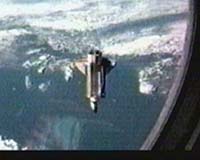 |
Washington DC (SPX) May 20, 2010 NASA's space shuttle Atlantis is delivering science experiments and a new Russian laboratory to the International Space Station, continuing the transition from station assembly to continuous scientific research through the end of the decade. The Russian-built Mini Research Module-1, also known as Rassvet (dawn in Russian), will host a variety of biotechnology, biological science, fluid physics and educational research experiments. Rassvet was attached Tuesday morning to the bottom port of the station's Zarya module. The shuttle crew will conduct nine short-duration experiments during the STS-132 mission and return samples from 16 space station experiments. They will help enable nearly 130 long-duration station experiments in biology, physical and materials sciences, technology development, Earth and space science. "The Mini Research Module-1 provides important new real estate for experiments to be conducted on the space station and will be a cornerstone of Russian laboratory facilities for years to come," said Julie Robinson, International Space Station program scientist at NASA's Johnson Space Center in Houston. "This new module enhances the station's research capabilities and enables new investigations to be performed." The laboratory contains a pressurized compartment with eight workstations equipped with facilities such as a glove box to keep experiments separated from the in-cabin environment; two incubators to accommodate high- and low-temperature experiments and a vibration isolation platform to protect payloads and experiments. It also will be used for cargo storage. The module contains four other workstations, complete with mechanical adapters, to install payloads into roll-out racks and shelves. On its exterior, Rassvet will piggy-back an experiment airlock destined for use outside the final Russian module, named the Multipurpose Laboratory Module, which is planned for launch in 2012. The 2005 NASA Authorization Act designated a portion of the station as a National Laboratory, accessible to other government agencies, commercial entities and academic researchers. Among the studies the STS-132 astronauts will conduct is the ninth in a series of U.S. National Laboratory Pathfinder experiments aimed at developing vaccines to fight disease-causing bacteria. The commercial payload will study how several different pathogenic organisms react to the microgravity environment. Previous similar experiments led to development of a potential vaccine for Salmonella bacteria that cause food poisoning. Approval from the Food and Drug Administration is being sought for this as an investigational new drug. Another commercial National Lab pathfinder, Cells-4, will examine cellular replication to determine the use of spaceflight to enhance or improve cellular growth processes used in ground-based research. The shuttle astronauts also will participate in a first-of-its-kind Canadian experiment called Hypersole that aims to determine how the sensitivity of the sole of the foot affects balance control. The shuttle crew delivered 10 experiments to the space station. These include: Genara-A, a European experiment that looks at how plants grow without gravity; Ferulate, a Japanese experiment to study the strength of cell walls in microgravity; Cube Lab, a low-cost, 1 kilogram platform for commercial and educational projects; an experiment that studies the properties of colloids, which are tiny solid particles suspended in liquid, in microgravity; and the Smoke and Aerosol Measurement experiment, which is a follow-on investigation to previous tests of smoke detection technology. Several experiments will return to Earth aboard Atlantis. Among these are an European Space Agency experiment that will document the nature and distribution of radiation inside the station and create a method to measure absorption rates in biological samples; the first samples of ceramic glasses produced in Space Dynamically Responding Ultrasonic Matrix System, or SpaceDRUMS, which enables samples of materials to be processed without ever touching a container wall; samples of pharmaceutical quality intravenous fluid produced for the first time in space; and the Canadian Space Agency's Advanced Plant Experiment-CSA2, which compares the genes and tissue of white spruce (Picea glauca) grown in space with those grown on Earth to help forestry researchers understand the influence of gravity on plant physiology, growth and wood formation.
Share This Article With Planet Earth
Related Links More information about the science performed aboard the International Space Station Shuttle at NASA Watch NASA TV via Space.TV Space Shuttle News at Space-Travel.Com
 Retire The Shuttle on Orbit
Retire The Shuttle on OrbitWashington DC (SPX) May 20, 2010 If I didn't know better I'd swear that NASA took many leaves out of Ray Kroc's book when they built the monolithic government agency that they have become. For those of you unfamiliar, Kroc was the entrepreneurial genius who took a couple of hamburger restaurants in California and turned them into the largest restaurant chain on this planet, McDonald's. One of the most radical changes that ... read more |
|
| The content herein, unless otherwise known to be public domain, are Copyright 1995-2010 - SpaceDaily. AFP and UPI Wire Stories are copyright Agence France-Presse and United Press International. ESA Portal Reports are copyright European Space Agency. All NASA sourced material is public domain. Additional copyrights may apply in whole or part to other bona fide parties. Advertising does not imply endorsement,agreement or approval of any opinions, statements or information provided by SpaceDaily on any Web page published or hosted by SpaceDaily. Privacy Statement |